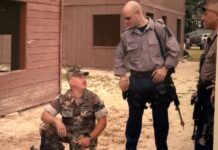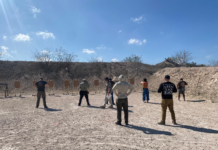When we think of training, we tend to focus on the more tangible elements involved: the skills and tactics, the drills, and, most commonly but incorrectly, the gear and equipment that we will use. These factors are like the visible part of an iceberg that we can see above the waves. However, like an iceberg, there is a huge chunk hidden below the surface that we don’t see – the fighting mindset that supports our efforts and from which everything else flows.
I was originally introduced to the Combat Triad, consisting of Marksmanship, Manipulation, and Mindset, by Bill Jeans of Morrigan Consulting in the mid-1990s when I was a young police officer. I now use it as an umbrella concept to guide proper training. The Triad encapsulates the skills and conditions necessary to win, and not just survive, a gunfight. The first two components are easy to explain and understand. They represent the visible part of the iceberg. Marksmanship is the ability to hit a desired target and manipulation is the consistent, efficient running of the gun. These two elements form the basis for gun fighting skills and need to be constantly practiced and refined.
Mindset, the third point on the triad, is a much harder concept to teach and to learn. It requires discipline and work. It must be embraced by the individual and incorporated into daily life.
Mindset can be broken down into:
- Mindset towards a threat. This is the easier of the two ideas to explain and is simply the willingness to do whatever is needed to win the fight. Words matter – we want to win the fight. It is not enough that we survive the encounter; we must strive to completely dominate it.
- Mindset towards training. This is a more difficult concept to convey. It is made up of the discipline and commitment to seek out quality training and subsequently engage in the proper practice of fundamental technique at all times. Manipulations and techniques must be performed consistently, all of the time. This constant, consistent repetition will lead to the ability to properly run the gun under times of extreme stress, the kind of stress that might be encountered in, say, a gunfight. We need to remember that, in a critical incident; a person will not rise to the occasion but rather will default to their level of training. By striving to always shoot and manipulate the gun in the same way, shooters can develop “unconscious competence” or the ability to perform necessary actions reflexively under stress without conscious thought.
History is replete with examples of when proper mindset was not built and instead was replaced with what was easier. There was the infamous shootout in Newhall CA in the early 1970s, where the last trooper was found shot to death with an empty revolver and a pocket full of spent brass. More recently, an encounter was caught on video where an officer performed a weapon disarm of a suspect holding him at gunpoint and then started to hand the weapon back to the bad guy. Both of these incidents happened because of lapses in focus during training. When short cuts are taken during training for expedience or simplicity, those practices become the standard.
I teach my students to be mindful of what they do because what they do can become habit. I structure my skill building drills to work towards the worst case scenario and work to keep consistency between manipulations. For example, in an administrative load the core movements mimic those of a proper presentation, a proper emergency reload, and a proper immediate action drill. We also see this methodology in longgun to handgun transitions. Rather than ending with the shooter re-holstering the sidearm and then simply running the charging handle on the carbine to reset the action, we teach to end by inserting a new magazine and loading a round, thus getting the carbine back in the fight. This method is more time consuming as it requires the weapon to be unloaded in order to set up for the next run of the drill but it is absolutely correct because it forces the shooter into the proper habit of getting the primary weapon back into a fighting condition. When I was the lead instructor for my agency’s rifle team, this was the way we ran the drill. We did so because we knew that it was not enough to tell our shooters that they should get the carbine back into the fight; they had to train to do so.
Building The Fighting Mindset
 Teaching someone to have a proper mindset is difficult in the extreme. A frequent topic of discussion amongst my fellow instructors is, if such a thing can even be accomplished, how does one best go about doing do. My feeling is that it must be explained and then shown by example. There are, however, several elements that are necessary and which will always be present in the fighting mindset.
Teaching someone to have a proper mindset is difficult in the extreme. A frequent topic of discussion amongst my fellow instructors is, if such a thing can even be accomplished, how does one best go about doing do. My feeling is that it must be explained and then shown by example. There are, however, several elements that are necessary and which will always be present in the fighting mindset.
The first element of a proper mindset is to seek out a proper foundation. The internet is, for the most part, not the best place to find “training.” As convenient as online surfing may be, so much of the available information is improperly explained or demonstrated, or is just outright wrong. The best opportunities for learning will come from attending a class with a vetted instructor. Select your teachers carefully and do not be afraid to ask questions. Look for an instructor who can explain what they teach and who will demonstrate the lessons. Check your ego at the door and be willing to learn.
Train with different instructors. So many in this industry teach from the same basic playbook but there are different perspectives and variations of techniques and principles. Another benefit to training with different people is in the way that information is presented. Two instructors may teach the same technique but may explain it in different ways. One way may resonate and make more sense than another. Not all techniques will work for all people. Training with a broad spectrum of experiences and backgrounds allows the student to take everything in, compile it, and end up with a system that works best for them and their circumstances.
In class, keep an open mind but don’t be afraid to ask questions. A good instructor will be able to back up what they teach and will strive to make sure information is flowing in both directions. I tell my students that “this is your class, not my class.” None of us know everything and everyone is capable of learning. We just have to be willing to invest our time and money into the process. Be willing to evolve. New information is constantly coming available. Avoid the latest fad; find what works for you and your environment. Evaluate your technique as you progress. As one’s abilities increase, so does one’s frame of reference and capacity for understanding. As a long time practitioner of Aikido, I experienced many instances where I was told something by my teacher that I simply wasn’t ready to hear. It wasn’t until later in my development that I was able to understand and incorporate the lesson into my practice.
 The second element is to practice proper technique in a consistent manner. There is no single class out there that one can attend and emerge a gunfighter. Training is a journey, not a destination. Constant, continued practice of proper skills in a consistent fashion is critical. We need to understand that every time a shooter fires or handles a weapon, they are training. Whether the training is beneficial or detrimental depends on the mindset and discipline of the individual. Bruce Lee is often quoted as saying “I fear not the man who has practiced 10,000 kicks once, but I fear the man who had practiced one kick 10,000 times.” The point being made is that simply performing a technique over and over does not necessarily produce a competent result. The skill must be consistently performed in order for it to become an accessible habit. Inconsistent repetitions are wasted repetitions. Worse, incorrect repetitions can build bad habits and produce training scars with deadly results. In order for our training to be beneficial and assist in building reflexive habit, it must be consistently executed and proper in its methodology. In other words, we have to practice the right techniques the proper way. The old adage that “Practice makes perfect” is a vicious lie; perfect practice makes perfect, practice alone only makes permanent.
The second element is to practice proper technique in a consistent manner. There is no single class out there that one can attend and emerge a gunfighter. Training is a journey, not a destination. Constant, continued practice of proper skills in a consistent fashion is critical. We need to understand that every time a shooter fires or handles a weapon, they are training. Whether the training is beneficial or detrimental depends on the mindset and discipline of the individual. Bruce Lee is often quoted as saying “I fear not the man who has practiced 10,000 kicks once, but I fear the man who had practiced one kick 10,000 times.” The point being made is that simply performing a technique over and over does not necessarily produce a competent result. The skill must be consistently performed in order for it to become an accessible habit. Inconsistent repetitions are wasted repetitions. Worse, incorrect repetitions can build bad habits and produce training scars with deadly results. In order for our training to be beneficial and assist in building reflexive habit, it must be consistently executed and proper in its methodology. In other words, we have to practice the right techniques the proper way. The old adage that “Practice makes perfect” is a vicious lie; perfect practice makes perfect, practice alone only makes permanent.
A crucial, and oft overlooked, part of a practice regimen is to have a plan. The unfortunate reality is that most folks’ training sessions are really just plinking. In order for training to be beneficial, it must be directed and trackable. Start with a clear plan, outlining both the skills to be worked and the standards to be met. Incorporate uncomfortable skills, such as support hand only manipulations, malfunction clearances, or unconventional positions. Left to our own devices, we tend to work more on things at which we are good. Having a training plan forces us to push ourselves and move out of our comfort zones. The use of standards allows us to quantify and track progress. Get a shooting buddy and a shot timer. Both will keep you honest about your progress.
The third element is one of applicability. Everything is fundamentals. As shooters progress up the ladder of skill, they discover that “advanced” training is nothing more than the fundamentals applied at speed and under stress. However, too many students confine themselves to the square range and never avail themselves of the opportunity to apply their skills to different environments and situations.
As an individual’s command of the fundamentals increases, we need to start pushing the limits of our comfort zone, in terms of speed and complexity, and ultimately begin to apply the fundamentals to realistic scenarios. I have structured my courses over the years to begin with skill building, expand to combination of skills, and finally graduate into applied exercises. Each of these stages offers its own sort of stress which forces the student to grow in order to be successful. I base my training on two measurements: what is the most likely threat scenario and what is the absolute worst case threat scenario. The majority of my practice is geared towards the first standard but I do not neglect the second.
 Finally, we have to think. Gunfighting is problem solving. All too often, I see students on auto-pilot and just going through the motions while on the range or becoming emotionally overloaded in more complex scenarios and losing the ability to process. We control the fight, not the other way around. Another instructor and I were recently discussing different range commands for initiating a sequence of fire. A concern was raised about the possibility that certain words, “shoot” or “gun” for example, might condition a shooter to reflexively fire their weapon upon hearing similar words shouted from a crowd. My answer to this was that a student is not engaging on my command, whatever word or action I use. I tell my students that the command is simply the stimulus that tells them there is a problem. It is up to them to decide what the appropriate response will be. In a shooting class, this typically is for them to fire but, the point is that they should be thinking their way through the problem that has been presented, from the decision to fire, the number of rounds to fire, and decision to stop shooting once the threat is determined to have been neutralized.
Finally, we have to think. Gunfighting is problem solving. All too often, I see students on auto-pilot and just going through the motions while on the range or becoming emotionally overloaded in more complex scenarios and losing the ability to process. We control the fight, not the other way around. Another instructor and I were recently discussing different range commands for initiating a sequence of fire. A concern was raised about the possibility that certain words, “shoot” or “gun” for example, might condition a shooter to reflexively fire their weapon upon hearing similar words shouted from a crowd. My answer to this was that a student is not engaging on my command, whatever word or action I use. I tell my students that the command is simply the stimulus that tells them there is a problem. It is up to them to decide what the appropriate response will be. In a shooting class, this typically is for them to fire but, the point is that they should be thinking their way through the problem that has been presented, from the decision to fire, the number of rounds to fire, and decision to stop shooting once the threat is determined to have been neutralized.
On the other end of the spectrum, in more complex environments, such as a live fire shoothouse, we are constantly reminding the students to keep control by slowing down, breathing, and not moving beyond their ability to process what they are seeing.
The fighting mindset is a critical part of training. Without it, we see students who search and assess a situation without actually seeing what’s around them. We see trainees who shoot to slide lock and then mindlessly holster an empty weapon and who take shortcuts in order to “win” at a drill. With mindset, we see shooters who are processing and problem-solving, who push themselves to their limits and beyond in order to get better, who keep their minds open and engaged, always looking for the edge.



